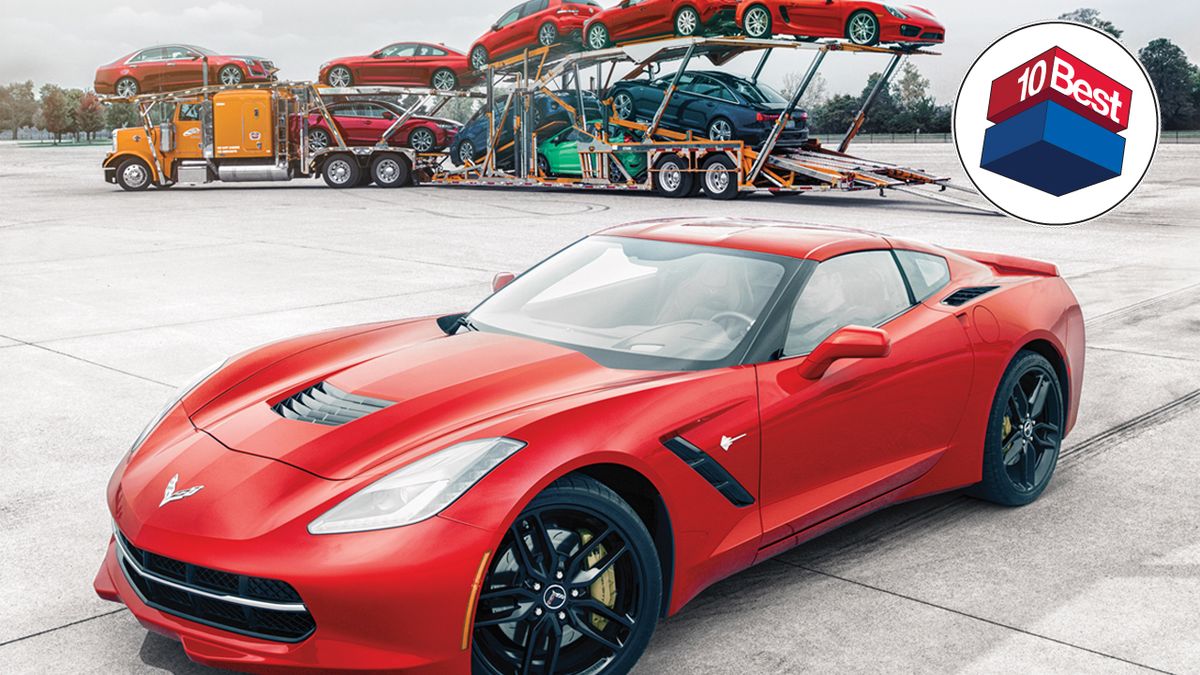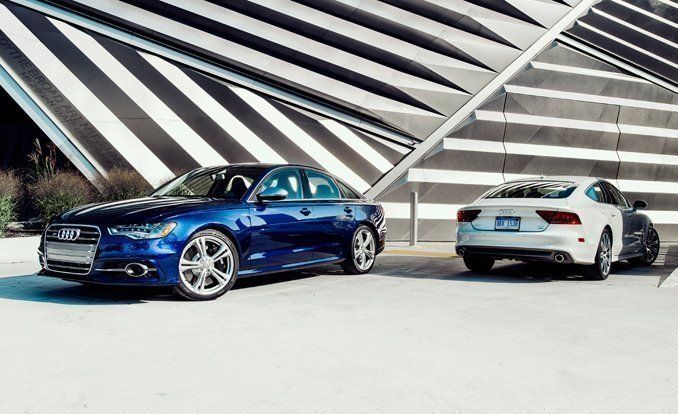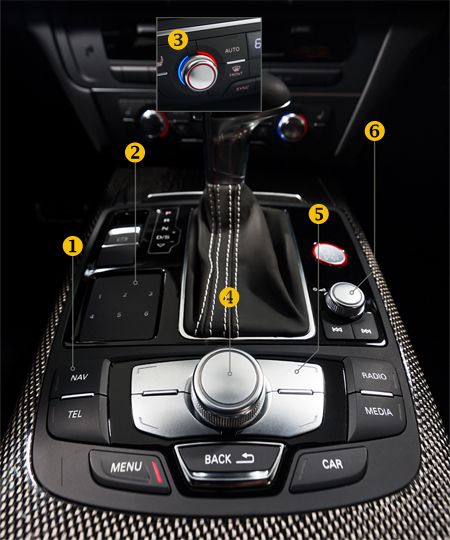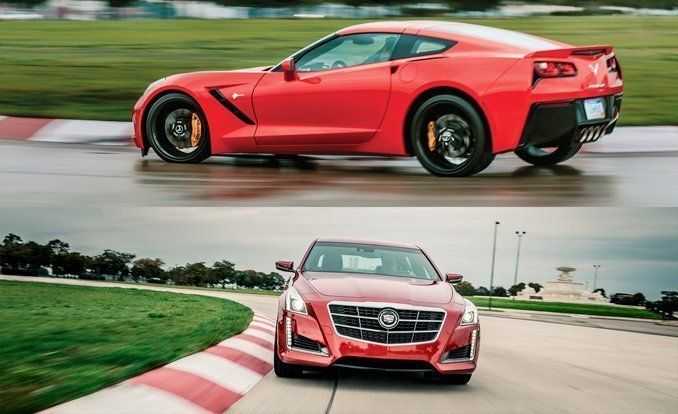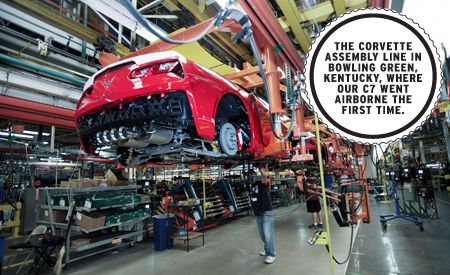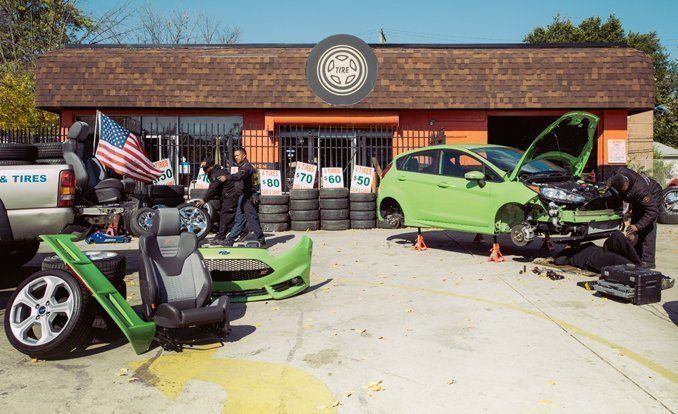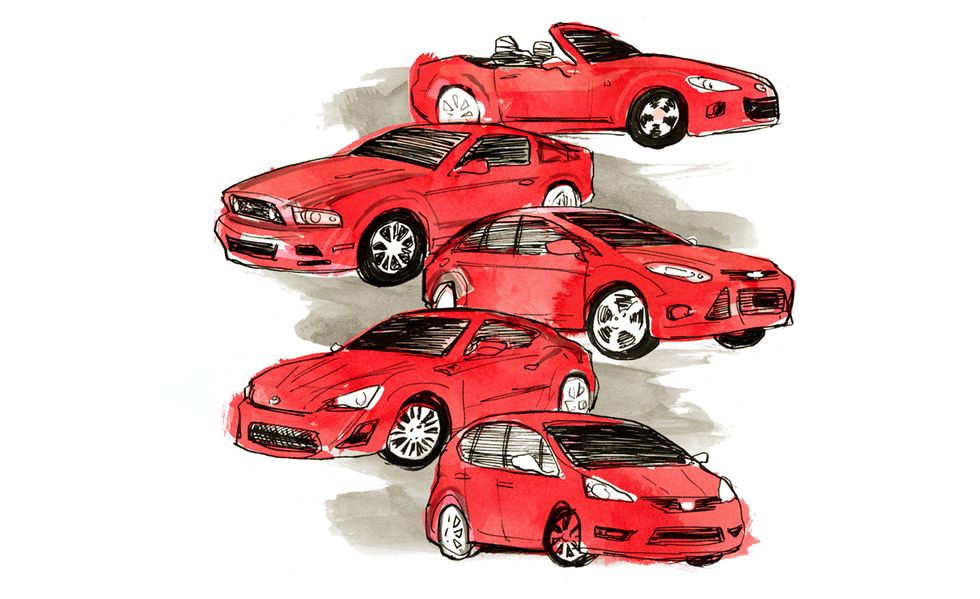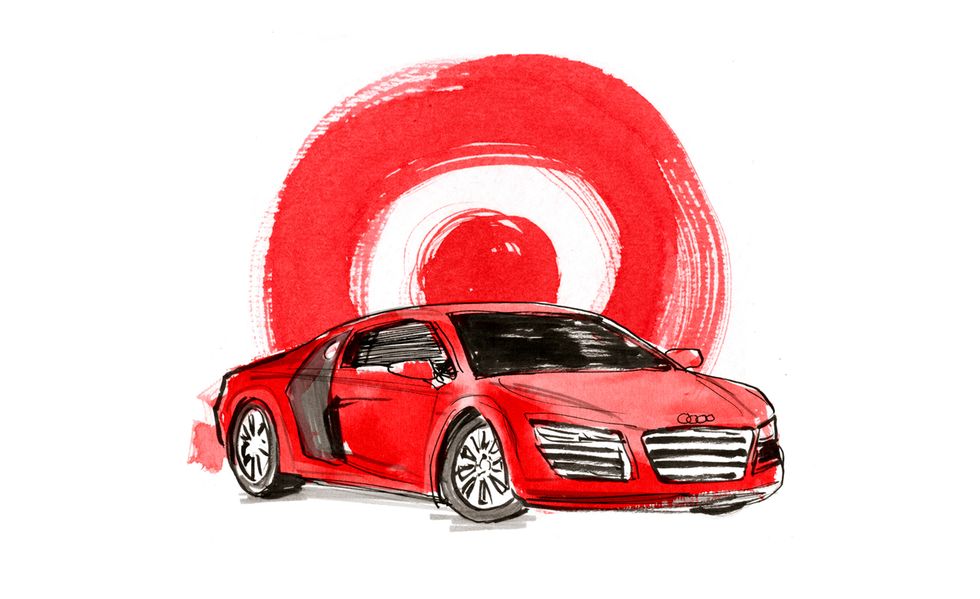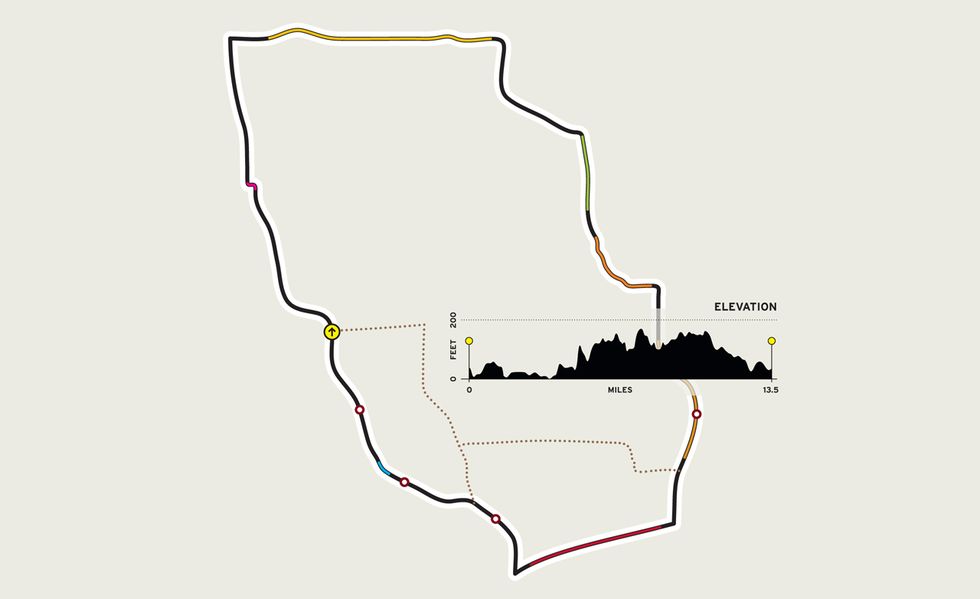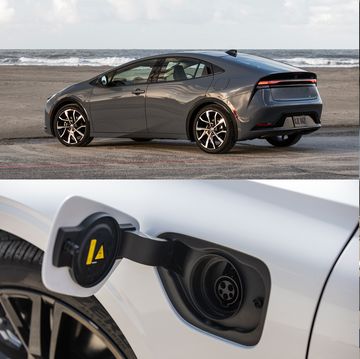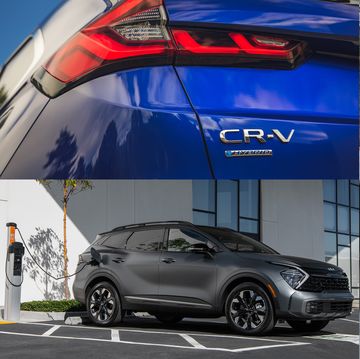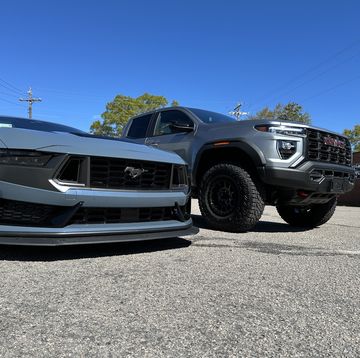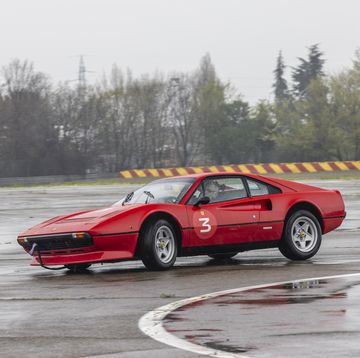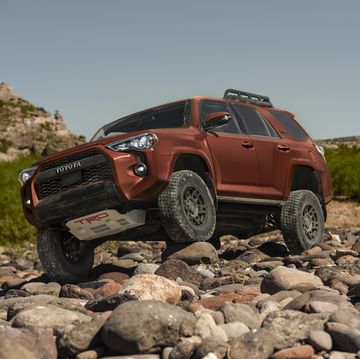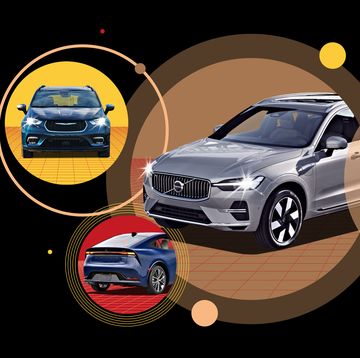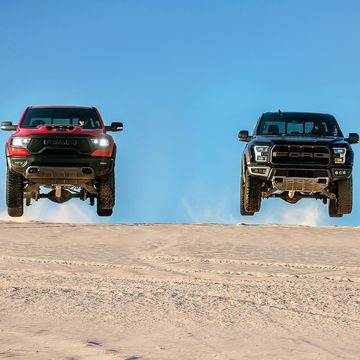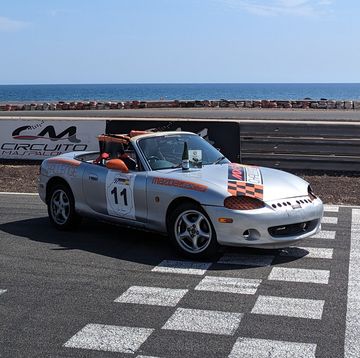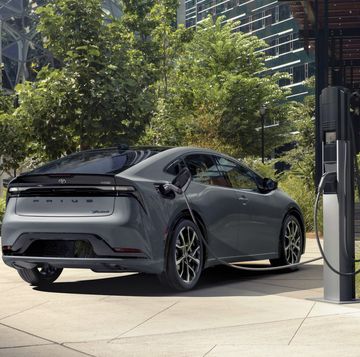There are a lot of bests out there—best summer movies, best places to live, best pizza joints within two miles of your current location. Our 10Best award is not one of those. These are cars we're talking about, people. We actually test these things.
For a full week each fall, we lock the office, turn off our phones, and engage in the most comprehensive and focused driving in the car-evaluation business.
Editors flog a dozen cars a day on the street and the track to determine everything from turn-in fidelity to the quality of a seat latch. What emerges is the fullest picture extant of the best cars on the market for under $80,000. These are the vehicles that offer the most value, that elegantly and comprehensively fulfill their missions, and that engage their drivers in spirited conversation. They are not always the newest or the trendiest, but they are the consistent overachievers. Cars like these don't escape from manufacturer focus groups all that often.
Which is why this year is so special. Five all-new cars replace a few stalwarts, redefining excellence for the entire industry. And fully half of our awardees start under $25,000. The following pages tell the whole story—how we drove and how we argued over and how we finally determined the winners. We think you'll find that most are available within a two-mile radius of your location.
THE WINNERS:
Audi A6 / S6 / A7
That life is not fair is one of its most important lessons. Some are born with what others work for; some are born to be who others work for; and some are born without any real concept of what work even is, but they get elected to public office just the same.
If you're the sort who's upset by such karmic imbalances, Audi's mid-sizers might bother you, as these cars have been given more than their fair share of gifts. They certainly bother BMW and Mercedes-Benz. There's nothing the Audis don't do well. When you've got 1000 freeway miles separating the morning's first cup of coffee and the comfort of your own bed, the A6, S6, and A7 are as serene as a suite at the Four Seasons. But when your fortunes take a turn toward blind crests and sphincter-cinching kinks, the Audis prove their adaptability with exemplary steering and body control. No matter the task, an overwhelming sense of solidity and unflappability pervades every move these Audis make.
They are as crisply designed as they are engineered, with deceptively simple exterior styling. And their interiors are not just well ordered, but meticulously and artfully so. Woods that look as though they might once have been the end tables in Neuschwanstein Castle segue into spears of satin chrome and rich stitched leathers, lending the impression that Audi is somehow budgeting three to five times more on materials than its competitors. Regardless of whether they control the HVAC, audio system, or the side mirrors, knurled knobs provide a rare consistency of feel thanks to a faction of the interior-design team that focuses solely on haptics, the science of touch. And the MMI infotainment system sets the standard for the rest of the industry.
Between the A6 and A7, Audi offers a choice of maximum passenger volume or a seductive roofline atop the same faultless mechanical base. Powertrain choices range from hyper-efficient—38 mpg highway with the 3.0-liter turbo-diesel V-6—to simply hyper—420 horsepower from the S6's twin-turbo V-8. Audi offers a 2.0-liter engine in the A6, but, as good as that engine is, Audi has never provided that model for evaluation. Audi's wing in the 10Best clubhouse is reserved for six- and eight-cylinder engines. With all of these various powertrain and body-style combinations, there's no way to go wrong, just a handful of different ways to go right.
Places on this list are awarded based on more than just numbers, but the S6's deserve special mention. Turn off stability control and flat-foot the throttle with the brake applied, and the launch control revs the engine to 5000 rpm before dumping the clutch. Not a single power stroke goes unused as all four fat tires hurl the car to 60 mph in just 3.7 seconds and through the quarter-mile in 12.1 at 115 mph. That makes this sedate-looking sedan quicker even than the new Corvette.
The Audi mid-sizers' only downside is cost. With a V-6, the A6 starts at $55,995; the A7 at $65,395. The S6's base price is $74,295, and a $1400 price bump from 2013 to '14 put the S7 over our $80,000 base-price cap, which was the only thing preventing its inclusion on this year's list.
Even at these prices, though, the cars are worth it. There are no-compromise sports cars and no-compromise luxury cars, but those sports cars typically compromise on comfort, and those luxury cars frequently compromise on performance. The Audis are genuine no-compromise cars: They don’t just offer something for everyone, they offer everything for anyone who can afford it.
Doing It Right
As people who care more about computers than cars demand more integration of the former into the latter, infotainment systems are becoming a huge deal. So huge, in fact, that “infotainment” is generally accepted as a real word. Just this past year, NHTSA side-stepped into the fray, publishing suggestions regarding control operation, screen location, and smartphone integration. Audi, on the other hand, has been refining infotainment’s exemplar for years. Its flagship technology, “MMI touch,” blends a central control knob with an array of hard buttons, soft buttons, disappearing buttons, and even a fingertip sketch pad, making it the least frustrating infotainment system we’ve ever used.
- ON SPEED DIAL
These hard buttons immediately call up the major submenus—navigation, phone, car setup, radio, and connected media. - WRITE NOW
Normally, six virtual buttons here call up the six radio presets. When you want to enter a destination, though, or use the onboard internet connection to look one up on Google, this touchpad turns into a fingertip-writing surface. That might sound distracting, but MMI is so good at discerning even the most illegible, absent-minded chicken scratch that it isn’t. - HOT AND COLD
Capacitive touch systems may look sleek, but how far do you need to swipe your finger to increase temperature by five degrees? Here, you always know: five degrees, five clicks—tactile, audible, Audi-spec clicks. - LARGE, IN CHARGE
More proof that touch screens are not the answer. Poking at a field in the middle of the dash requires far more focus than does twirling a knob. - INNER CIRCLE
In each submenu, these buttons take on different functions as indicated by labels in the corners of the MMI screen. - EXTREMELY LOUD? INCREDIBLY CLOSE
Ever notice how some radio stations are louder than others? Or that your iPod is quieter than the radio? Many infotainment systems leave all the major functions down on the center console but strand the volume knob up on the center stack. But here, just a small wrist flick separates the major system controller from the volume knob. Immediately below the volume knob are the seek/skip buttons.
Specifications
VEHICLE TYPE
front-engine, 4-wheel-drive, 5-passenger, 4-door sedan or 5-door wagon
BASE PRICE
$55,995–$74,295
ENGINES
turbocharged and intercooled DOHC 24-valve 3.0-liter diesel V-6, 240 hp, 428 lb-ft; supercharged and intercooled DOHC 24-valve 3.0-liter V-6, 310 hp, 325 lb-ft; twin-turbocharged and intercooled DOHC 32-valve 4.0-liter V-8, 420 hp, 406 lb-ft
TRANSMISSIONS
7-speed dual-clutch automatic with manual shifting mode, 8-speed automatic with manual shifting mode
CURB WEIGHT
4100–4400 lb
EPA FUEL ECONOMY
City/highway: 17–24/27–38 mpg
BMW 3- and 4-series / Honda Accord
Alistair Cooke would have called it a quintessentially American success story: Two foreigners land on our shores from nations once defeated and destitute to seek fortunes in the land of their conqueror. Lofted to unimaginable heights by the updraft of postwar prosperity, they become business empires unto themselves.
How much should we read into the common narratives of Honda and BMW? Both are smaller firms relative to the giants of the industry, yet they have remained steadfastly independent as others have buddied up into global conglomerates. Both companies have an inordinately strong sense of identity, rooted in engineering and nurtured at some point in their histories by a single patron or family. Both make motorcycles. And after nearly four decades of continuous success in America, the BMW 3-series and the Honda Accord are themselves automotive dynasties.
The Honda Accord is perfectly named, the result of a timely accord between Japan's burgeoning industrial might and America's rapidly changing post-OPEC market. The first Accord in 1976 was a huge stride from the series of mostly obscure subcompacts that preceded it. Building on the Civic CVCC, the Accord was a polished and precision Japanese instrument in the mold of a contemporary Sony tape recorder or a Nikon camera, and it threw Detroit's complacency into glaringly sharp relief.
Even so, the Accord is America's Honda. We own it, and it is ours. It was the first Japanese car to be assembled here—indeed, in the middle of America, in Rust-Belt Ohio—and it grew and morphed with the needs of its prime constituency, the baby-boom generation. It even contributed to an American-style scandal in the 1980s when the demand for Hondas far outstripped the supply and the company's U.S. sales managers skimmed millions in bribes and kickbacks from dealers desperate for stock.
On the showroom floor, the Accord displayed engineering elegance that anybody could appreciate, from the perfectly placed cabin controls and the painstakingly efficient packaging to the meticulously routed hoses and cables under the hood. In motion, an Accord was light, thrifty, fun, practical, and incredibly durable. Honda sealed its reputation with the Accord, and the car has consistently adhered to its core values through nine generations.
There isn't a bad apple in the bushel, but the 1994–1997 fifth-gen is a particularly warm memory. The sheetmetal was wrapped tightly, the hoodline sloping down to two illuminated slits for headlights. It was the first Accord with a V-6 and the first with panache as well as purpose. It drove like it, immediately rendering all other cars in its class contenders for second place. Since then, the Accord has grown and matured—undoubtedly too much in the just-retired eighth generation. But the redesigned 2013 Accord returned to form as a slightly smaller but still unapologetically practical vehicle with acres of glass for visibility, a capacious cabin, and that same spry lightness to its controls and movements. Once again, the Accord became the standard by which the largest and most competitive class of passenger cars is judged.
As with Honda, BMW is, at heart, a small-car company—an ingrained idiosyncrasy that is perhaps the reason it nearly collapsed in the 1950s when it tried to produce a series of expensive, handmade sedans and coupes. The ensuing boardroom turmoil and threat of takeover by Daimler-Benz is what allowed Herbert Quandt and his brother Harald to wrest control of the company in 1959 and steer BMW toward its destiny as the purveyor of small and boxy ultimate driving machines. It's the reason that the 3-series has always been better than the 5 and the 7.
From the start, the 1977 BMW E21 3er and its successors have been built the way common-sense enthusiasts would build their cars. The axle loads are nearly equal on a trim and tidy rear-drive platform with exactly enough room to serve practical needs. No inches or pounds are wasted, and nothing but an inline engine will do. Even as others have yielded to the temptations of a V-6 or front-drive, with their inherent packaging benefits, BMW has stuck to its formula.As each new 3-series debuted, from E30 to E36, and E46 to E90, there was never a question of whether there would be a manual transmission offered, never a doubt that a sport package or an M version would cure whatever plushness BMW had conceded for wider market acceptance. Unquestionably, BMW benefited from the floundering of its competitors; Mercedes-Benz answered with a dynamic also-ran, and then its quality went into a decade-long spiral before climbing back out, and it took Audi 20 years to recover from unintended acceleration. The Japanese and American brands were off the radar.
Even people whose car passions flow elsewhere have a favorite 3-series generation, but we couldn't develop a consensus in the office. Was it the elemental E30; the fully flowered, do-it-all E90; or one in between? At one time the 3-series was half of BMW's volume in the U.S., but the best-selling luxury brand in America has lately borne a lot of kittens, and the lineup is diluted. Even at around 37 percent of BMW's U.S. sales for the first nine months of 2013, the 3 remains both a profit fountain for BMW as well as the ideological center of its brand.
Today, the 3 wears a bull's-eye on its back as every luxury maker now takes aim at the fat, lower end of the luxury-car segment, which is the $35,000–$45,000 (or $399–$499/month) compact sports sedan. The current F30, which in its initial 320i, 328i, and 335i form, or 428i/435i as per the coupe's new designation, is softer than ever and suffers from imperfect electrified steering.
But it still bears the burdens of its leadership with understated, everyday excellence. Anchoring to the road with a balletic balance and a satisfying exactness to its controls, the 3 also delivers the premium experience—of powertrain isolation, switch feel, and ride quality—expected of its premium price.
In some ways, the 3-series feels like an expensive Accord, which feels like an economy 3-series. Which is exactly what has ensured both such long tenures on our 10Best list.
Specifications
Honda Accord
VEHICLE TYPE
front-engine, front-wheel-drive, 5-passenger, 2-door coupe or 4-door sedan
BASE PRICE
$22,745–$34,270
ENGINES
DOHC 16-valve 2.4-liter inline-4, 185 or 189 hp, 181 or 182 lb-ft; SOHC 24-valve 3.5-liter V-6, 278 hp, 252 lb-ft
TRANSMISSIONS
6-speed manual, 6-speed automatic, continuously variable automatic
CURB WEIGHT
3250–3550 lb
EPA FUEL ECONOMY
City/highway: 18–27/28–36 mpg
–
BMW 3- and 4-series
VEHICLE TYPE
front-engine; rear- or 4-wheel-drive; 4–5-passenger; 2-door coupe, 4-door sedan, or 5-door wagon
BASE PRICE
$33,675–$48,925
ENGINES
turbocharged and intercooled DOHC 16-valve 2.0-liter inline-4, 180 hp, 200 lb-ft; turbocharged and intercooled DOHC 16-valve 2.0-liter inline-4, 240 or 241 hp, 255 or 258 lb-ft; twin-turbocharged and intercooled DOHC 24-valve 3.0-liter inline-6, 300 or 302 hp, 295 or 300 lb-ft
TRANSMISSIONS
6-speed manual, 8-speed automatic with manual shifting mode
CURB WEIGHT
3350–3750 lb
EPA FUEL ECONOMY
City/highway: 20–24/28–36 mpg
Chevrolet Corvette Stingray / Cadillac CTS
The numbers car: It looks great on paper, and then you drive it. Though able to bruise internal organs during acceleration, braking, and cornering tests, the numbers car is usually too anodyne and too remote to foster lasting relationships with serious drivers. In most cases, it's not much fun unless it's at a test track doing the one thing it does well—generating numbers. Numbers might not lie, but sometimes they skip to the last page.
GM has built its share of number generators in the past. But subordinating the feel of a car to raw metrics doesn't lead to great cars, just great Excel files. Judging from the new Cadillac CTS and Chevrolet Corvette, GM now knows how to bridge the gap between the driver and the spreadsheet. These cars aren't simply about the cold pursuit of data. They’re about the interaction between human and machine.
So what separates a numbers car from a driver's car? Steering feel, for a start. Steering tells the story of the car in motion, and in the Corvette it reports the squirm of the tires and, by varying the resistance, every tenth-of-a-g change in cornering force. Information pulses through even more staccato in the CTS, if you can believe it, but the Corvette's steering is hugely improved over its C6 predecessor's.
Second, the suspension tune has to harmonize with the steering for the car to feel right. Engineers have to find the ideal spring, damper, anti-roll-bar, and bushing calibrations so the body and suspension react in concert with the driver's inputs. Add a structure stiff enough to let the suspension do its job and a gearbox that spurs on the engine, and you have a car that will provoke stupid grins every time you drive it.
It is true that previous Corvettes came alive and got talkative when pushed to the edge. While the Corvette was doing anything else, though, such as fetching take-out Thai food, the controls went mute. But the new C7 is talking up a storm.
The thing is just so well honed. Not only is its electrically assisted steering system unexpectedly sensitive, you can practically feel the thousands of man-hours spent developing its Michelin tires, its stiffer structure, and, on Z51 models, its electronically controlled limited-slip differential. Even on narrower rubber, the C7 has grip figures on par with the outgoing Z06. So, okay, numbers aren't totally irrelevant. They're just not everything.
The Cadillac hasn't quite made the same leap as the Corvette, but it didn't have to. The CTS has always been the Cadillac for people who prefer solid handling to landau roofs. At its birth in '03, however, the CTS seemed to prioritize numbers ahead of the driving experience. What's unusual about the CTS is that it represents GM persevering against its worst, most empirically driven instincts, methodically evolving the car's mechanicals and ladling on more feel with each generation. Yes, the General has flirted with putting experience ahead of the numbers before, but it never took. Remember the Oldsmobile Achieva SCX, Cutlass Calais 442 W41, and the Chevrolet Citation X-11? No? That's because GM stopped suckling those sales runts. But the General has stuck with the CTS, making each successive model a more refined and entertaining sports sedan. The CTS is now unequivocally the best-handling car in the mid-size luxury segment.
Ironically, by focusing less on the numbers and more on tactile sensations, GM has achieved a rare numerical feat: two cars on our 10Best list.
5 Ways GM Keeps the Corvette Cheap
- GM manufactures more than a million Gen-V V-8s for its cars and trucks each year at three North American plants. All these engines have modern aluminum construction, direct injection, and variable cam timing. While the Corvette’s 6.2-liter LT1 version has special features, such as header-like exhaust manifolds and (optional) dry-sump lubrication, its architecture is common to the Gen-V family, enabling huge economies of scale.
- By GM’s measurements, the LT1 is 40 pounds lighter and 4.3 inches shorter in height than BMW’s twin-turbo DOHC 4.4-liter V-8, which produces comparable power and torque. The LT1’s oft-disparaged pushrod valvetrain saves more than 150 parts and significant cost. Figure on more than $25 saved on valves alone for each LT1 engine.
- To slip a light and stiff aluminum space frame under all 2014 Corvettes instead of just the elite Z06 and ZR1 editions, GM moved the construction of that vital part in-house. A new, $52 million line at the Corvette plant in Bowling Green, Kentucky, uses robots and automated laser welding to nearly eliminate the human aspect from this phase of the manufacturing process.
- Corvette supplier Plasan Carbon Composites invented a “hot oil pressure press system” that the firm’s chief technology officer, Gary Lownsdale, calls, “the first major step toward mass production of carbon-fiber components.” Compared with traditional autoclave molding and curing techniques, the new methodology reduces process time by 75 percent—from 90 minutes to just 17 per part. Corvette hood and roof panels come out of their molds with such high quality that robots can be used for trimming and scuffing. The faster curing and 80-percent reduction in finishing time yield a 30-percent cost reduction.
- To reduce the cost and complexity of maintaining every last Corvette part in inventory, Chevrolet hired Brembo to build C7 corner modules for just-in-time delivery to Bowling Green. Brembo gathers these subassemblies—including the suspension knuckles, wheel hubs, brakes, speed sensors, and other parts in the Corvette’s wheel wells—and delivers them to the plant in batches of four modules per car. But this is one cost savings that’s not exclusive to Corvette: Brembo has been supplying Aston Martin, Ferrari, and Porsche with corner modules for years.
Specifications
Chevrolet Corvette Stingray
VEHICLE TYPE
front-engine, rear-wheel-drive, 2-passenger, 2-door targa
BASE PRICE
$51,995
ENGINES
pushrod 16-valve 6.2-liter V-8, 455 or 460 hp, 460 or 465 lb-ft
TRANSMISSION
7-speed manual, 6-speed automatic with manual shifting mode
CURB WEIGHT
3450 lb
EPA FUEL ECONOMY
City/highway: 16–17/28–29 mpg
–
Cadillac CTS
VEHICLE TYPE
front-engine, rear- or 4-wheel-drive, 5-passenger, 4-door sedan
BASE PRICE
$46,025–$59,995
ENGINES
turbocharged and intercooled DOHC 16-valve 2.0-liter inline-4, 272 hp, 295 lb-ft; DOHC 24-valve 3.6-liter V-6, 321 hp, 275 lb-ft; twin-turbocharged and intercooled DOHC 24-valve 3.6-liter V-6, 420 hp, 430 lb-ft
TRANSMISSIONS
6-speed automatic with manual shifting mode, 8-speed automatic with manual shifting mode
CURB WEIGHT
3700–4000 lb
EPA FUEL ECONOMY
City/highway: 17–20/25–30 mpg
Ford Fiesta ST
The Fiesta ST lift-throttle oversteered into 10Best week like the champ it is. And aside from a cramped back seat and cargo hold, its bravado is justified. Ford offers its hot Fiesta only with a six-speed manual mated to a turbocharged, direct-injected 1.6-liter four borrowed from the Fusion. At 2750 pounds, the ST is light and tossable, with a highly competent chassis that can out-party cars costing twice as much.
Unlike the 252-hp tire-smoking Focus ST, every last one of the Fiesta's 197 horses is usable 100 percent of the time. Torque steer is all but nonexistent, with just the tiniest little tug in the wheel in first and second gears, as if the engine were a curious two-year-old at your elbow asking questions. While you should surely lift off the throttle on corner entry to get this little enthusiast trainer's back end to step out, you'll never find yourself lifting on corner exit—there's just the right amount of understeer baked into the balance. Just the right amount of feedback, too, from major controls that provide all the answers.
That this all starts with an economy car is only surprising until you look at what Ford changed. The company claims that the ST has 164 special components, including most everything that matters. The result is as good as fun, cheap driving gets.
Parts Car
- The rear wing, fascias, and side sills are specific to the ST, and though they make the Fiesta look like a WRC car, that’s all they do. The optional Recaro seats, on the other hand, are the real deal. If you can get comfortable in them—not everyone can—consider your money well spent.
- The rear torsion beam uses heavier-gauge steel than the non-ST version’s, making it 70 percent stiffer. Also, the rear tires have much less negative camber, -0.6 degree versus -1.5, to reduce rear-axle grip, thus providing a more neutral balance. Bushings at the rear are also firmer than those fitted to a standard Fiesta.
- Ford redesigned the front suspension knuckles for more negative camber, -1.2 degrees versus -0.7, benefiting at-the-limit grip. The knuckles’ slightly shorter steering arms quicken the steering ratio from 14.3:1 in the base car to 13.6:1 here. The geometry changes also raise the roll center, thus diminishing body roll compared with the base car.
- Spring rates are up all around, by 20 percent in the rear and 36 percent in the front. A higher roll center and stiffer springs enable a smaller front anti-roll bar (0.7-inch diameter) versus what’s in the regular Fiesta (0.9-inch diameter).
- The 10.9-inch front brake rotors are larger than a stock Fiesta’s by 0.7 inch. Ford also exchanges the standard Fiesta’s rear drum brakes for 10.0-inch discs. Bridgestone Potenza RE050A summer tires, in size 205/40R-17, come standard.
Specifications
VEHICLE TYPE
front-engine, front-wheel-drive, 5-passenger, 5-door hatchback
BASE PRICE
$22,195
ENGINES
turbocharged and intercooled DOHC 16-valve 1.6-liter inline-4, 197 hp, 202 lb-ft
TRANSMISSION
6-speed manual
CURB WEIGHT
2750 lb
EPA FUEL ECONOMY
City/highway: 26/35 mpg
Mazda 6 / Mazda 3
We have an $80,000 base-price cap for the vehicles invited to 10Best, and for good reason: It's easier to build a great car if it will command a great price. And frankly, the thrill of some megabuck über-cars fades even more rapidly than those machines accelerate. Don't misunderstand us; we're not saying that squabbling over the keys to a Ferrari is not worthy of fisticuffs, or that driving a Bugatti shouldn't be on your bucket list. But the cars of privilege are extremists, pulling everything else along in their wake. It can be just as gratifying to slide behind the wheel of those mainstream models that have tucked into that slipstream.
Mazda proves it with two such standouts named to 10Best this year: the 3 and the 6. Even when they're well equipped, you could own the pair for less than 80 grand and still have enough change to buy a new Miata. Mazda's venerable roadster dropped off our list this year, not for being eclipsed by a direct competitor, but in deference to its new siblings—cars brimming with the sort of vigor and personality that the Miata brought to the summer of 1989.
The compact 3 and mid-size 6 are perfectly timed products from a company that many had presumed down for the count. Two years ago, Mazda was losing billions, and analysts talked of a potential bankruptcy. Abandoned by Ford, its longtime partner, Mazda would need its next crop of cars to stand on its own, with zero margin for error. Tiny Mazda finished just 13th in U.S. sales in 2012, at the back of the pack with lowly Mitsubishi. That's not much higher than Maserati, which wishes it had a sedan as beautiful as the 6 in its stable.
The new 6 delivers Mazda's 2010 Shinari concept essentially intact to its 637 U.S. dealers. The 6 not only looks like a million bucks inside and out, it drives like it. Mazda's long-held reputation for selecting suspension bushings is on prominent display in the 6, which has an imperturbable chassis that is always comfortable and controlled. Its steering, suspension, and structure coordinate deftly. A six-speed manual is available, yet its automatic shifts so quickly and effortlessly that the 2.5-liter four feels more robust than any 184-hp engine has a right to.
The uncommon commonality of this pair of Mazdas is that both are so much better than expected. Mazda tells us its parts work better together because of its Skyactiv concept—a holistic approach to design, manufacturing, and fuel-saving technologies that began with the previous-generation 3. But it's in these newest models that Skyactiv seems most alchemical. Stiffer and lighter structures—the 6 sheds more than 200 pounds in its redesign—translate to improved handling. Engines with a lofty 13.0:1 compression ratio and direct injection help boost fuel economy as high as 41 mpg on the EPA highway cycle. Keeping with the company's iconoclasm, its optional i-ELOOP electrification system makes Mazda the first automaker to employ capacitors in a regenerative braking system.
In some ways, the 3 is the more impressive car here. Whether it's the hatchback or sedan, we can't stop admiring the long hood and Italianate grille of the new 3, which hides its front-drive underpinnings as well as anything since the original Oldsmobile Toronado. Interior appointments, including an excellent infotainment system with a central command knob, set a new, Audi-like standard for the class. An optional head-up speedometer display projects its data onto a transparent pane on the dash, fighter-jock style, and keeps your eyes up and on the road.
Mazda offers the 6's 2.5-liter in the 3, as well as an entry-level 155-hp 2.0-liter four, but neither is neck-snappingly powerful. The Mazdas aren't here because of their brawn. These are finesse cars, balanced and ergonomically perfect. Their cowls are low, their sightlines are unencumbered, and Mazda hasn't done anything silly such as jacking the front seats' H-points to make its cars feel more like crossovers; its excellent CX-5 already serves that purpose.
Indeed, Mazda is punching above its weight class when it comes to product. For a company that builds one-sixth the number of vehicles of giants like General Motors, Toyota, and Volkswagen, its achievements are nothing short of shocking, like Buster Douglas knocking out Mike Tyson. Mazda has no luxury brand to generate Lexus-size profits, not even a high-margin pickup truck in its lineup. No, Mazda just sells efficiently built small and mid-size cars and crossovers, all of them entertaining and none with a base price above $31K. In an industry in which most carmakers are trying to be everywhere at once, Mazda's dedication to doing what it does best earns it our highest acclaim.
Specifications
Mazda 6
VEHICLE TYPE
front-engine, front-wheel-drive, 5-passenger, 4-door sedan
BASE PRICE
$21,785–$30,490
ENGINES
DOHC 16-valve 2.5-liter Atkinson-cycle inline-4, 184 hp, 185 lb-ft
TRANSMISSIONS
6-speed manual, 6-speed automatic with manual shifting mode
CURB WEIGHT
3150–3300 lb
EPA FUEL ECONOMY
City/highway: 25–28/37–40 mpg
–
Mazda 3
VEHICLE TYPE
front-engine, front-wheel-drive, 5-passenger, 4-door sedan or 5-door wagon
BASE PRICE
$17,740–$27,290
ENGINES
DOHC 16-valve 2.0-liter Atkinson-cycle inline-4, 155 hp, 150 lb-ft; DOHC 16-valve 2.5-liter Atkinson-cycle inline-4, 184 hp, 185 lb-ft
TRANSMISSIONS
6-speed manual, 6-speed automatic with manual shifting mode
CURB WEIGHT
2800–3100 lb
EPA FUEL ECONOMY
City/highway: 27–30/37–41 mpg
Porsche Boxster / Cayman
There is no first place in 10Best. Officially then, the Porsche Boxster and its newly reworked tin-topped brother, the Cayman, are exactly equal to the other cars on our list.
But lean in close now because we're going to let you in on a secret: The Porsches are the winners among these winners.
Unlike several of the other cars here, the Porsches' place on the list was never in doubt. Over our morning (and midday, and afternoon) doughnuts, we'd debate the relative merits of the Honda Accord and the Mazda 6 and whether the combined forces of BMW's 3- and 4-series would be able to meet the challenge presented by the Lexus IS350. But there was no discussion of the Boxster and Cayman. They were on everyone's list, and that was that.We've spilled so much ink in praise of these two, that this story could consist of two words: Of course. But in case you've missed our fawning, here's the rundown.
The secret to this duo's success is that they somehow manage to feel so organic, so genuine, in a world full of simulated, electro-distant experiences. That they achieve this while employing the same technologies that make other cars feel synthetic is a type of magic.The Boxster and Cayman's steering system isn't of the non-assisted, purist-pleasing variety. It's not even hydraulically boosted. It is an EPS (electric power steering) system, three letters that strike fear and revulsion into the hearts of most sports-car fans. That uniquely Porsche flat-six timbre is augmented by a facsimile of engine noise piped into the snug little cabin. Optionally available is the pricey sport exhaust system ($2825) that gives you effectively a two-stage volume control—those two stages being quiet and 11. There are available adjustable shocks (PASM, $1790), an automatic-shifting dual-clutch transmission (PDK, $3200), and a launch-control system that relieves the driver from even having to know what a holeshot is.
So how is it possible that, with all of this interference by technology, the Boxster and Cayman remain authentic feeling?
Don't know. But when you turn the satin-aluminum-trimmed SportDesign steering wheel ($490), it's like turning a high-fidelity rheostat of joy. With this level of feel, accuracy, and composure, the steering system could be boosted by flaming cow patties and we'd still park a Boxster or Cayman in our garage.
Your intentions zing from steering wheel to suspension to tire almost before you realize you have any such intentions. Yes, the car posts adult levels of grip on the skidpad (right around 1.00 g for both base and S Boxsters), but achieving those figures is child's play compared with what these cars can do away from the calm of the asphalt lake and out in the scarred, undulating, unpredictable place known as the real world. Nothing is better at staying the course with absolute ease, come what may. These cars never lose their cool, never become perturbed. They simply go about their work with effortless tenacity.
Yes, Porsche makes extensive use of its own famed Weissach test track and the equally famed Nürburgring Nordschleife to hone the ride and handling characteristics of its cars, including these two. But then, developing a car at the 'Ring has become commonplace enough that its use alone cannot explain why the Boxster and Cayman have transitional behavior so lively, stable, and natural that their bodies feel like extensions of their drivers', even as other 'Ring warriors leave us cold. Could it be that the difference here is just a group of the world's best engineers developing a car with a clear and unwavering focus?
You can easily find quicker cars, cars with higher top speeds, and goodness knows you can find less-expensive cars, but you simply cannot find cars any more satisfying to operate than this duo. Oh, and they're gorgeous, too.
Specifications
VEHICLE TYPE
mid-engine, rear-wheel-drive, 2-passenger, 2-door roadster or coupe
BASE PRICE (BOXSTER)
$51,350–$63,050
BASE PRICE (CAYMAN)
$53,550–$64,750
ENGINES
DOHC 24-valve 2.7-liter flat-six, 265 hp, 207 lb-ft; DOHC 24-valve 3.4-liter flat-six, 315 hp, 266 lb-ft; DOHC 24-valve 2.7-liter flat-six, 275 hp, 213 lb-ft; DOHC 24-valve 3.4-liter flat-six, 325 hp, 272 lb-ft
TRANSMISSIONS
6-speed manual, 7-speed dual-clutch automatic with manual shifting mode
CURB WEIGHT
2900–2950 lb
EPA FUEL ECONOMY
City/highway: 20–22/28–32 mpg
Volkswagen Golf / GTI
It doesn't matter whether our German brothers dub it a Golf or a Rabbit or a pine marten. What we have here, folks, is a winner with momentum. This is the eighth consecutive year that the VW Golf lineup, the lone GTI, or both have earned 10Best laurels. What Belushi and Aykroyd did for rumpled black suits, Volkswagen has done for hatchbacks.
Even the starter-kit five-door Golf automatic is a piquant stew of near-flawless fundamentals, and you can slide your cheeks into one for as little as $20,815. The TDI turbo-diesel is the Earth Firster's happy hummer, a torque weasel that will make you feel marginally less guilty about climate change. With a manual shifter, a TDI five-door starts at $26,020. Both of these Golfs are gratifyingly balanced and composed if very different in acceleration. Their cabins are swathed in uplevel materials and pleasing surfaces. The unibody is a Mason jar of airtight rigidity. The suspension is unflustered by scabrous pavement. The steering's effort builds naturally off-center. And the IP is dedicated to the serious minded.
As we've said several times before, the Golf remains an unlikely partnership of practicality and refinement. Rarely do economy cars so fervently reward precise inputs. Rarely has an econohatch been hobbled by so few compromises.
Of course, it's the driver-focused GTI that is the wolf in Wolfsburg's clothing. You can own a five-door manual Wolfsburg Edition GTI for only $25,915. This little comet still defines the hot-hatch class it created way back in 1976, and it still begs to be booted around like a hacky sack. The damper calibrations feel like the outcome of engineers who really care, with roll gorgeously controlled, yet the ride remains creamy and the brakes don't fade.
The taut GTI glides to fame with one of automobiledom's all-star drivelines: VW's 200-hp, rev-happy, turbocharged 2.0-liter inline-four—with its delightful punch of midrange torque—mated to the optional paddle-shift dual-clutch DSG automatic ($1100). Never has plaid felt so fashionable or more happily been hustled. Drive it to the Home Depot on Saturday morning; enter an SCCA autocross at noon. How unlikely is it for a car this basic to feel so sophisticated, so mature, as if hatched in Munich or Ingolstadt? One C/D editor noted, "The GTI pours itself down the road, a fluid stream of disciplined control." Okay, so that’s not exactly Faulkner, but we're trying.
The GTI is not without pimples, of course. We still wish its clutch and brake pedals telegraphed slightly more info up the driver's leg. On dry days with unlimited downrange visibility, we'd like to disable the traction control—completely. If it were up to us, we'd redact a smidgen of the existing understeer, and we'd also undertake all of our GTI motoring exclusively on summer tires, right until the moment that two snowflakes coalesce above.
It's amazing that this sixth-gen Golf landed on 10Best again, because it's what we call "almost over, not yet out." The seventh-gen Golf—riding on the so-called MQB platform—will arrive this spring. It will be lighter, stronger, and longer by 2.2 inches, and in GTI spec, its engine should be at least 10 horses healthier. Note also that it will be assembled in Mexico for the first time since the third-gen cars. We've already sampled Euro-spec versions. They again seem likely to become the canny gray wolf that somehow gets dropped into a box of Labrador puppies—big toothsome bites of fun in a scary-good way. (That's not Faulkner, either. More like the Columbus Zoo's Jack Hanna.)
Specifications
VEHICLE TYPE
front-engine, front-wheel-drive, 5-passenger, 5-door hatchback
BASE PRICE
$20,815–$26,020
ENGINES
turbocharged and intercooled DOHC 16-valve 2.0-liter diesel inline-4, 140 hp, 236 lb-ft; DOHC 20-valve 2.5-liter inline-5, 170 hp, 177 lb-ft; turbocharged and intercooled DOHC 16-valve 2.0-liter inline-4, 200 hp, 207 lb-ft
TRANSMISSIONS
6-speed manual, 6-speed dual-clutch automatic with manual shifting mode, 6-speed automatic with manual shifting mode
CURB WEIGHT
3100–3200 lb
EPA FUEL ECONOMY
City/highway: 21–30/30–42 mpg
10BEST VIDEOS:
Choosing the 10Best Cars for 2014
Car and Driver's 10Best Cars for 2014
10BEST EXTRAS:
Gonged But Not Forgotten
10 We Wish Existed
The Also-Rans
The Route and What It Tells Us
Car and Driver 2014 10Best Invitees
10BEST DATA ROUNDUP
HORSEPOWER
LOW: Mazda 3 i - 155
HIGH: Chevrolet Corvette - 460
MEDIAN: 259
MEAN: 267
BRAKING (70–0 mph, feet)
LONG: Volkswagen GTI - 187
SHORT: Chevrolet Corvette - 146
MEDIAN: 170
MEAN: 166
1/4-MILE TIME/SPEED
SLOW: Mazda 3 i - 16.3 sec @ 87 mph
FAST: Chevrolet Corvette - 12.2 sec @ 117 mph
MEDIAN: 14.5 sec @ 100 mph
MEAN: 14.4 sec @ 100 mph
WEIGHT (pounds)
HIGH: Audi A6 - 4105
LOW: Ford Fiesta ST - 2745
MEDIAN: 3364
MEAN: 3346
CENTER OF GRAVITY (inches)
HIGH: Ford Fiesta ST - 23.0
LOW: Chevrolet Corvette - 17.5
MEDIAN: 21.8
MEAN: 21.1
SKIDPAD (g)
LOW: Mazda 3 i - 0.82
HIGH: Chevrolet Corvette - 1.08
MEDIAN: 0.87
MEAN: 0.90
10BEST BY THE NUMBERS
Landau vinyl tops:
0, sadly
Naps taken:
5
Naps interrupted by the sound of tree trunks snapping:
1
Times John Phillips told that story about falling backward off a log and waiting for his wife to collect him:
17
Vehicles wearing a "Gran Turismo" badge that were actually just big hatchbacks:
1
Days with rain:
1
Doughnuts purchased:
240
Doughnuts consumed:
239.7
Key fobs lost:
3
Clay pigeons launched:
173
Clay pigeons hit:
49
Times Daniel Pund said, "Did you drive the Fiesta ST? That thing's great!":
11
Convertibles driven:
4
Moving violations:
0
Steps a turkey vulture makes retreating from roadkill as traffic nears:
2, sometimes less
Miles driven:
13,770
Editors who participated:
17
Overheatings:
2
Cars that overheated:
1
Bar tab for the week-ending dinner:
$836
CAR AND DRIVER 10BEST ORDINANCE OF 1983
ARTICLE I • DEFINITIONS
1.1 Car: sedan, coupe, roadster, convertible, or wagon less than 64.4 inches tall.*
1.2 Base price: the current MSRP of any vehicle including any and all destination charges and gas-guzzler tax, if applicable.
ARTICLE II • PURPOSE
2.1 To determine 10 cars on a yearly basis that most excel in the areas of driving fun and execution of intended purpose and that offer an excellent value for the consumer.
ARTICLE III • ELIGIBILITY
3.1 To qualify, a car must adhere to 3.1.a, 3.1.b, 3.1.c, or 3.1.d; 3.1.e, and 3.1.f.
3.1.a Any all-new car or new sub-model in a vehicle line that previously competed in 10Best.
3.1.b Any significantly updated car, a definition that encompasses changes to its powertrain, chassis, or both. Any changes including—but not limited to—exterior colors, interior trim, restyled fascias, or nonessential equipment such as perfume atomizers do not meet 3.1.b.
3.1.c Any model unavailable for the previous running of 10Best, so long as the model does not violate 3.1.c.i or passes a vote† under 3.1.c.ii.3.1.c.i If a vehicle is unavailable for two consecutive years, it will not get a third invitation. Exception:3.1.c.ii A car may be granted a stay of execution if the 10Best committee chair-in-chief (Alterman) calls for a vote† and committee members (everyone else) reach a majority. This has never happened. Ever.
3.1.d Any 10Best winner from last year.
3.1.e A car must be on sale by January 31 of the 10Best year and in production, even if said car qualifies under 3.1.c or 3.1.d.
3.1.f Must have a base price of $80,000 or less.‡*The height of the original Subaru Forester, which is the point at which a crossover swings both ways.†The committee has 10 members, and the chair-in-chief's vote counts as 11 votes.‡Often referred to as the diminishing-return article, because above 80 grand you're just paying for mink glove-box liners and perfume atomizers. Sometimes.
Click here for our 2015 10Best Cars.

